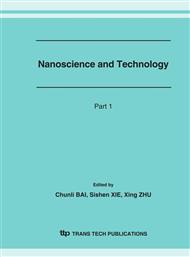[1]
Gerard O'Sullivan, EUVL Source Workshop, Antwerp 2003; available at www. sematech. org.
Google Scholar
[2]
Zeljko Andreic et al., Performance of the 13. 5 nm PVC Capillary Discharge EUV Source, Physics Letter A, 335 (2005) 430-434.
DOI: 10.1016/j.physleta.2004.12.061
Google Scholar
[3]
H. Horita, A. Kimura, H. Imamura, C.H. Zhang, S. Katsuki, T. namihira and H. Akiyama, Characteristic of Z-pinch EUV Source with Tin Target , Proc. Of the 3rd EUVL Symposium, Miyazaki, Japan, Nov. 1-4, (2004).
Google Scholar
[4]
Richard H. Stulen and Donald W. Sweeney, Extreme Ultraviolet Lithography, IEEE Journal of Quantum Electronics, Vol. 35, No. 5, pp.694-699, May (1999).
DOI: 10.1109/3.760315
Google Scholar
[5]
William T. Silfvast, Intense EUV Incoherent Plasma Sources for EUV Lithography and Other Applications, IEEE Journal of Quantum Electronics, Vol. 35, No. 5, pp.700-708, May (1999).
DOI: 10.1109/3.760316
Google Scholar
[6]
K. Bergmann, O. Rosier, R. Lebert, W. Neff and R. Poprawe, A Multi-kilohertz Pinch Plasma Radition Source for EUVL, Microelectronic Engineering, 57-58, pp.71-77, (2001).
DOI: 10.1016/s0167-9317(01)00437-3
Google Scholar
[7]
S. Katsuki, A. Kimura, A. Hongo, T. Sakugawa, H. Akiyama, Z-pinch EUV Source Driven by 100 ns Current Pulses, 2nd EUVL Symposium, Antwerp, Belgium, 09/30~10/1, (2003).
Google Scholar
[8]
E.R. Kieft, J. van der Mullen and G.M.W. Kroesen, Time-resolved pinhole camera imaging and extreme ultraviolet spectrometry on a hollow cathode discharge in xenon, Physical Review E, 68, 056403, (2003).
DOI: 10.1103/physreve.68.056403
Google Scholar
[9]
W. Neff et al., Pinch Plasma Radiation Sources for the Extreme Ultraviolet, Contrib. Palsma Phys., 41 (2001) 6, 589-597.
DOI: 10.1002/1521-3986(200111)41:6<589::aid-ctpp589>3.0.co;2-z
Google Scholar
[10]
H. Legall et al., Spatial and Spectral Characterization of a Laser Produced Plasma Source for Extreme Ultraviolet Metrology, Review of Scientific Instruments, Vol. 75, No. 11, pp.4981-4988, (2004).
DOI: 10.1063/1.1807567
Google Scholar
[11]
Winnie Svendsen and Gerard O'Sullivan, Statistics and characteristics of xuv transition arrays from laser-produced plasmas of the elements tin through iodine, Phys. Rev. A 50, 3710, (1994).
DOI: 10.1103/physreva.50.3710
Google Scholar


